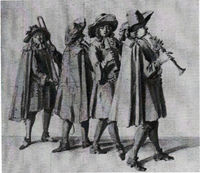Annotation:London Waits: Difference between revisions
No edit summary |
m (Text replacement - "garamond, serif" to "sans-serif") |
||
| (One intermediate revision by one other user not shown) | |||
| Line 1: | Line 1: | ||
=='''Back to [[{{BASEPAGENAME}}]]'''== | =='''Back to [[{{BASEPAGENAME}}]]'''== | ||
---- | ---- | ||
<p><font face=" | <p><font face="sans-serif" size="4"> | ||
'''LONDON WAITS.''' AKA and see "[[Past Three O'Clock]]." English, Air (3/4 time). G Major. Standard tuning (fiddle). ABC. This Waits' air was turned into a Christmas carol (as "Past Three O'Clock", words by George Ratcliffe Woodward, 1848–1934) and appears in some collections of those songs. It was published by Playford in his '''Supplement to the Third Edition of the Dancing Master''' (1657, where it appears simply as "The Waits"), and in '''Apollo's Banquet''' of 1669. Waits were paid musicians of towns and corporations, especially by the 15th and 16th centuries, and each group had some special tune to which they gave their name e.g. "[[Chester Waits]]," "[[Colchester Waits]]." In the year 1575 the livery of the London Waits, states Chappell (1859), was described in a contemporary chronicle as "blue gowns, red sleeves and caps, every one having his silver collar about his neck." | '''LONDON WAITS.''' AKA and see "[[Past Three O'Clock]]." English, Air (3/4 time). G Major. Standard tuning (fiddle). ABC. This Waits' air was turned into a Christmas carol (as "Past Three O'Clock", words by George Ratcliffe Woodward, 1848–1934) and appears in some collections of those songs. It was published by Playford in his '''Supplement to the Third Edition of the Dancing Master''' (1657, where it appears simply as "The Waits"), and in '''Apollo's Banquet''' of 1669. Waits were paid musicians of towns and corporations, especially by the 15th and 16th centuries, and each group had some special tune to which they gave their name e.g. "[[Chester Waits]]," "[[Oxford Waits]]," "[[Colchester Waits]]." In the year 1575 the livery of the London Waits, states Chappell (1859), was described in a contemporary chronicle as "blue gowns, red sleeves and caps, every one having his silver collar about his neck." | ||
[[File:waits.jpg|200px|thumb|left|English Waits c. 1680. A wash drawing attributed to Marcellus Laroon]] | [[File:waits.jpg|200px|thumb|left|English Waits c. 1680. A wash drawing attributed to Marcellus Laroon]] | ||
<br> | <br> | ||
<br> | <br> | ||
</font></p> | </font></p> | ||
<p><font face=" | <p><font face="sans-serif" size="4"> | ||
''Source for notated version'': | ''Source for notated version'': | ||
<br> | <br> | ||
<br> | <br> | ||
</font></p> | </font></p> | ||
<p><font face=" | <p><font face="sans-serif" size="4"> | ||
''Printed sources'': Barlow ('''Complete Country Dances from Playford's Dancing Master'''), 1985; No. 163, p. 46. Chappell (Popular Music of the Olden Time), vol. 2, 1859; pp. 10-11. | ''Printed sources'': Barlow ('''Complete Country Dances from Playford's Dancing Master'''), 1985; No. 163, p. 46. Chappell (Popular Music of the Olden Time), vol. 2, 1859; pp. 10-11. | ||
<br> | <br> | ||
<br> | <br> | ||
</font></p> | </font></p> | ||
<p><font face=" | <p><font face="sans-serif" size="4"> | ||
''Recorded sources'': <font color=teal></font> | ''Recorded sources'': <font color=teal></font> | ||
</font></p> | </font></p> | ||
Latest revision as of 14:16, 6 May 2019
Back to London Waits
LONDON WAITS. AKA and see "Past Three O'Clock." English, Air (3/4 time). G Major. Standard tuning (fiddle). ABC. This Waits' air was turned into a Christmas carol (as "Past Three O'Clock", words by George Ratcliffe Woodward, 1848–1934) and appears in some collections of those songs. It was published by Playford in his Supplement to the Third Edition of the Dancing Master (1657, where it appears simply as "The Waits"), and in Apollo's Banquet of 1669. Waits were paid musicians of towns and corporations, especially by the 15th and 16th centuries, and each group had some special tune to which they gave their name e.g. "Chester Waits," "Oxford Waits," "Colchester Waits." In the year 1575 the livery of the London Waits, states Chappell (1859), was described in a contemporary chronicle as "blue gowns, red sleeves and caps, every one having his silver collar about his neck."

Source for notated version:
Printed sources: Barlow (Complete Country Dances from Playford's Dancing Master), 1985; No. 163, p. 46. Chappell (Popular Music of the Olden Time), vol. 2, 1859; pp. 10-11.
Recorded sources:
